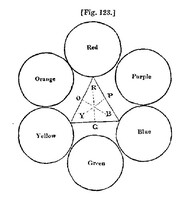21. Sir Isaac Newton (Prop. 6. part 2, of book i. Optics,) has given a method for judging of the colour of the compound in any known mixture of primary colours, but it is not easy, even for mathematicians, to put his rules in practice. The gentleman who consulted me on this subject of shadows, has been accustomed, for a long time, to assist his memory, when he is painting, by the use of the simple diagram [fig. 123]. Let R, Y, B, represent the three uncompounded colours, red, yellow, blue; and let O, G, P, represent the compounds orange, green, and purple; it is evident that, to make a deeper orange, we must add more red; and to make a bluer green, we must add more blue; and to make the purple redder, we must add more red, and vice versa: but besides this, the diagram puts us in mind that G is the contrast to R, and that, therefore, those two colours cannot be mixed without approaching to a dull whiteness, or greyness; and the same may be said of Y and P, and of B and O: these colours are also contrasts to each other; by mixture they destroy each other, and produce a whiteness, or greyness, according as they are more or less perfect; but when kept distinct, they are found to make each other look more brilliant by being brought close together: and all this is agreeable to what is said in Sect. 11, and in the note to Sect. 14.

